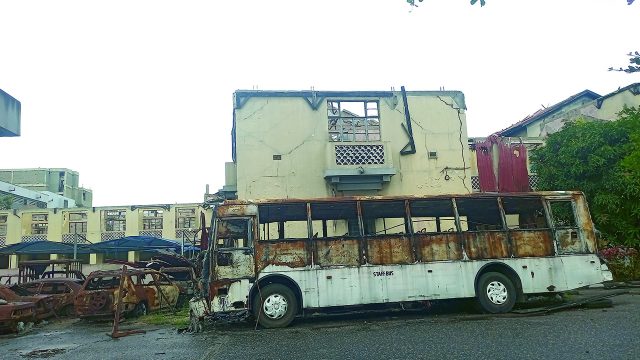By Yetunde Ayobami Ojo
Relics of the burnt Igbosere Court
• Rebuilding Process Ongoing, Says LASG Almost a year after October 20, 2020, the #EndSARS crisis during which the Igbosere High and Magistrate Courts in Lagos Island were razed and vandalised by protesters, the Lagos State government is yet to start the rehabilitation of the structures. This is contrary to the promise made by Governor Babajide Sanwo-Olu after the incident.
The agony of the destroyed court edifices peaks as the Lagos Judiciary prepares to hold its annual legal year service on September 27. The parade of the guard ceremony, which usually takes place in front of Foyer Building, Lagos High Court, Igbosere, Lagos from time immemorial would not hold there this year due to the current state of the structure. The colourful parade of the guard ceremony is part of the activities to mark the new legal year in Lagos. Unfortunately, that glitz and glamour would be missed this year.
It is a yearly tradition that takes place after the Muslim and Christian faithful have finished their thanksgiving services in the Church and Mosque. Workers of the judiciary, lawyers, judges, and retired judges, friends, and relatives usually gather in the court premises at Igbosere, being the oldest court in the country and a symbol of justice, to celebrate and usher in the new legal year. The Igbosere High Court building is the oldest and most recognised judicial building in Nigeria.
Not less than 100 Police personnel and their musical band corps normally grace the occasion and form part of the Judiciary Guard Parade. They appear in their ceremonial dress, which gives visitors the opportunity to see a vibrant display of pomp and pageantry as a highlight of the legal ceremonial calendar.
Since last year October when scores of hoodlums burnt down the Igbosere High Court and the Magistrates’ Court, carting away computers, printers, files, fans, air conditioners, and other valuable items, the structure has remained a relics.
Some judicial workers and lawyers who spoke with The Guardian during the week lamented that nothing much has been done by the Governor Sanwo-Olu government to rehabilitate the structure, wondering how long it will take the government to put the structure back in shape.
Meanwhile, the Chief Judge, Justice Kazeem Olanrewaju Alogba has announced Monday, September 27, 2021, as the opening of 2021/2022 New Legal Year for the Lagos judiciary.
The annual thanksgiving for the year will hold at the Central Mosque, Nnamdi Azikwe Street, and Cathedral Church of Christ, 29, Marina Lagos simultaneously by 9 am prompt. While Parade of Guard follows at the TBS instead of the normal parade ground, Igbosere.
When The Guardian visited the High Court and Magistrate Court, the gates remained shut. Burnt vehicles and other exhibits still littered the premises, which hosted the courtroom of Justice Babajide Candid-Johnson, Justice Atinuke Ipaye, Justice Kudirat Jose, Justice Lateefa Okunnu, and Justice I.O Harrison, among others.
On November 4, 2020, Governor Sanwo-Olu signed an Executive Order to establish an eight-man Lagos State Rebuilding Trust Fund, headed by Mr. Yemi Cardoso to rebuild the razed edifice.
While inaugurating the committee, the governor promised that it had put the criminal destruction behind it and was committed to the huge task of rebuilding the state. The government, he said, would be embracing new standards of governance and building stronger partnerships, which would enable the state to bequeath stronger institutions and cohesion among residents.
When contacted, the Commissioner for Information and Strategy, Mr. Gbenga Omotosho dismissed the insinuation that the government has neglected the razed structure or is doing nothing to revive necessary activities in the affected places.
According to him, “Government has not neglected the relics neither is it drag footing as some are feeling. The destruction was massive and it would require a lot of money and expertise to fix. “Remember that the government set up a committee to handle the rehabilitation and building of the edifices, which definitely requires public and private partnership. You may contact the chairman of the committee for further details.” When also contacted on phone, Cardoso said, “First and foremost, this whole thing started as a committee of government but it is no longer a committee of government. It was subsequently decided that we would set up an independent arms-length entity limited, for credibility purposes. This will help us to have something independent because, at that point in time, there will be a lot of concerns over many things. What we have is a lot of public entities that will have the presence of private and government. It is now a Public-Private Partnership (PPP), which has its own status and laws for procurement policies and others. The governance and the legality of it will obviously face its own time. If it is a committee of government, it would have started work immediately but in this case, you have to ensure that it goes through CAC and other necessary procedure.”
Cardoso added: “Secondly, which is also very important, is that to rehabilitate the destruction you saw is more than putting bricks and mortar together. When we talk about rebuilding, we need to go beyond merely fixing the edifices; we have the task to as well help rebuild the future. “To ensure that whatever bricks and mortar we put there stands the test of time, you have to make substantial provision to ensure that what happened last year does not repeat itself. So, in the process of doing all these, you need to reach out and make sure that you carry necessary stakeholders along and create confidence in what you are doing.”

